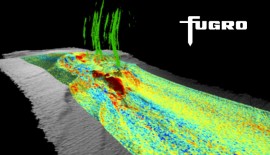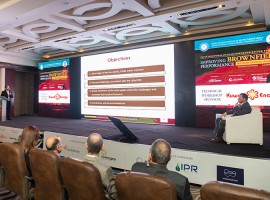By Dr. Abdel Moneim Abu Shady, Logging Director, SinoTharwa
Mud logging is the creation of a detailed record – a well log – of a borehole by examining the cuttings of rock brought to the surface by the circulating drilling medium; most commonly known as drilling mud.
In an oil field drilling operation, mud logging technicians determine positions of hydrocarbons with respect to depth, identify down-hole lithology, monitor natural gas entering the drilling mud stream, and draw well logs for use by oil company geologists. Rock cuttings circulated to the surface in drilling mud are subsequently sampled and analyzed.
Mud logging provides well owners and producers with information about the lithology and fluid content of the borehole while drilling. It is the earliest type of a well log. It may begin on the first day of drilling, known as the ‘spud in’ date, but it is more frequently deployed at a later stage determined by the oil industry geologist’s research.
As it happens, mud logger may also possess logs from wells drilled in the surrounding area. This information, which is known as ‘offset data,’ can provide valuable clues as to the characteristics of the particular geo-strata that a rig crew is about to drill through.
Mud Logging Processes
Mud loggers connect various sensors to the drilling apparatus and install specialized equipment to monitor or ‘log’ drill activity.
Mud logging technicians observe and interpret the indicators in the mud returns during the drilling process, and at regular intervals log properties such as drilling rate, mud weight, flowline temperature, oil indicators, pump pressure, pump rate, lithology of the drilled cuttings, and other data. The acquired information is organized in the form of a graphic log.
Another important task of the mud logger is to monitor gas levels and types in order for appropriate steps to be taken to avoid a dangerous well blowout condition.
As there is a lag time between drilling and the point when the mud and cuttings return to the surface, a modern augmentation has come into use – Measurement While Drilling (MWD). The MWD provides the data that is different in source and content thanks to expensive and complex, electronic tools that are installed down-hole at or near the drill bit.
Equipments require precise calibration or alignment by the mud logger to provide accurate readings, and innovations are crucial.
Mud Logging in Egypt
SinoTharwa Drilling Company started the Creative Mud Logging System (CMS) project in 2012 as its integrated services in Egypt, which has marked successful performance.
CMS is a global leading explosion-proof mud logging unit, applicable to onshore and offshore drilling rigs. It integrates advanced computer network technique with the fastest gas chromatographic analysis technique, explosion-proof CAN BUS data transmission technique, accurate and reliable sensor technique, geochemical evaluation of rock samples, Nuclear Magnetic Resonance analysis technique (NMR), and Quantitative Fluorescence analysis Technique (QFT).
A CMS mud logging unit can measure more than 60 parameters directly and derive more than 200 parameters of the analysis.
The main parameters include:
Gas Parameters
Total Gas, C1, C2, C3, iC4, nC4, iC5, nC5, H2S, and CO2
Engineering Parameters
HKLD, WOB, SPP, TORQ (Electrical, Mechanical, Top drive), RPM (Top drive), SPM1, and SPM2
Mud Parameters
Pit level, total pit level, gain/loss, mud return flow of mud, mud temperature in/out, mud density in/out, and mud conductivity in/out
Depth Parameters
Well depth, ROP, Bit position, Off bottom, etc.
Geological Parameters
Geochemical anal, quantitative fluorescence, Nuclear Magnetic Resonance, Shale density, and carbonate anal etc.
SinoTharwa’s Operations
SinoTharwa applied its first CMS unit and started the operations with PetroSilah in El Fayoum Desert with 100% profitability in May 2013. SinoTharwa has totally drilled 27 exploration and development wells.
The second mud logging unit was launched with El Mansoura Oil Company in Nile Delta in March 2014. While applying the technique, the company drilled 8 directional wells until now. Further, its contract was renewed to last until 2018.
By the end of 2015, SinoTharwa also won a tender of three CMS units with Qarun Petroleum company, and the third mud logging unit started operations by December 2015. SinoTharwa drilled 8 development and exploration wells to the date.
In addition, the company has purchased 3 new Creative Mud Logging Units in order to fulfill its obligations, having won a new contract with Qarun, and Petrobel. SinoTharwa also participated in other mud logging tenders with PetroAmir, PetroShad HBS, Petrodara, and GUPCO, seeking to expand its operations.
SinoTharwa is continually adopting new strategies to sustain the company’s prominence and competitiveness in the drilling market.
SinoTharwa Drilling Company was established in 2005 as a joint venture between Tharwa Petroleum Company – a subsidiary of the Egyptian Ministry of Petroleum & Mineral Resources – and China’s Sinopec Star Petroleum Company. It is a service company, providing support to oil & gas exploration companies. The company occupies one of the forefront positions with a 14% stake in the Egyptian market, and it has the second largest drilling contractor position in Egypt. SinoTharwa currently owns and operates 18 rigs; 13 land drilling rigs, 4 work over rigs and 1 offshore rig.








